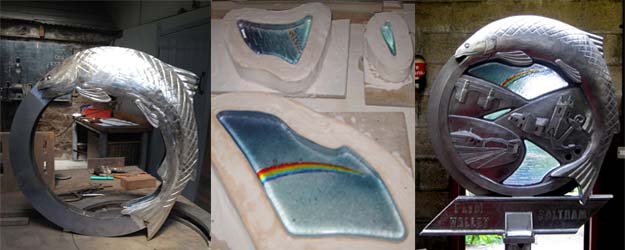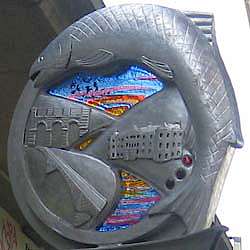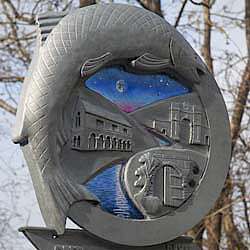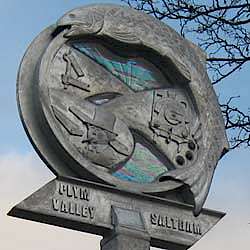Waymarkers for the Saltram and Plym Valley Heritage Trail
In 2013, Plymouth City Council commissioned seven waymarkers
For the improved Plym Valley Walking and Cycling Heritage Trail which links Saltram Estate to the Plym Woods, via Marsh Mills.This was a particularly interesting project for me for several reasons. It was an opportunity to collaborate with metalsmiths Thrussell and Thrussell of Bodmin, Cornwall - as I work alone a lot of the time, it was refreshing to be involved in a joint project. Also glass and steel are such different materials it was exciting to bring them together, and we hoped that each would enhance the other.

It was a chance as well for me to learn more about casting glass. The galvanised steel frames would offer some protection from potential damage, but even so, we decided to make the glass inserts about 40mm thick, for safety. Glass of this thickness needs a mould to keep it in shape as it melts, so it was a different way of working for me.
The circular shape of each waymarker was formed by the leaping salmon and the locomotive wheel, natural and man-made elements to be found in the Plym valley. The central panel of each is unique - the metalwork links with features in the landscape and the history of the area where each sign is located, while the glass areas of each show different skies and their reflection in the river.
 Under the A38 , near Marsh Mills roundabout. The waymarker features nearby Saltram House, and an evening sky with rooks heading home to roost.
Under the A38 , near Marsh Mills roundabout. The waymarker features nearby Saltram House, and an evening sky with rooks heading home to roost.  Plym Bridge car park. This waymarker shows a peregrine falcon and the Cann Viaduct, both of which can be seen nearby.
Plym Bridge car park. This waymarker shows a peregrine falcon and the Cann Viaduct, both of which can be seen nearby.  Saltram riverside , on the cycle path
Saltram riverside , on the cycle path  Coypool Road , near to the Plym Valley Railway. It features a steam train, and Isambard Kingdom Brunel. The glass shows a sky at dawn.
Coypool Road , near to the Plym Valley Railway. It features a steam train, and Isambard Kingdom Brunel. The glass shows a sky at dawn.  Saltram Estate , to the north of Saltram House. The oak leaf symbol is a reference to the National Trust, which manages the house and countryside park. The glass shows a sunny sky with seagulls- just some of the birds to be seen on the estuary here.
Saltram Estate , to the north of Saltram House. The oak leaf symbol is a reference to the National Trust, which manages the house and countryside park. The glass shows a sunny sky with seagulls- just some of the birds to be seen on the estuary here.